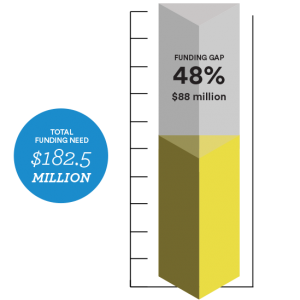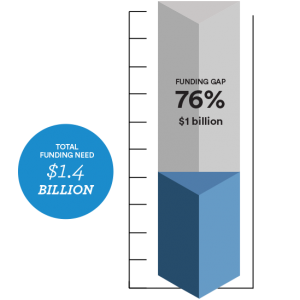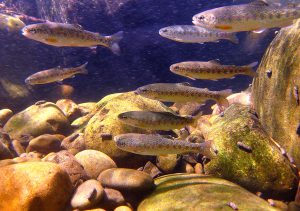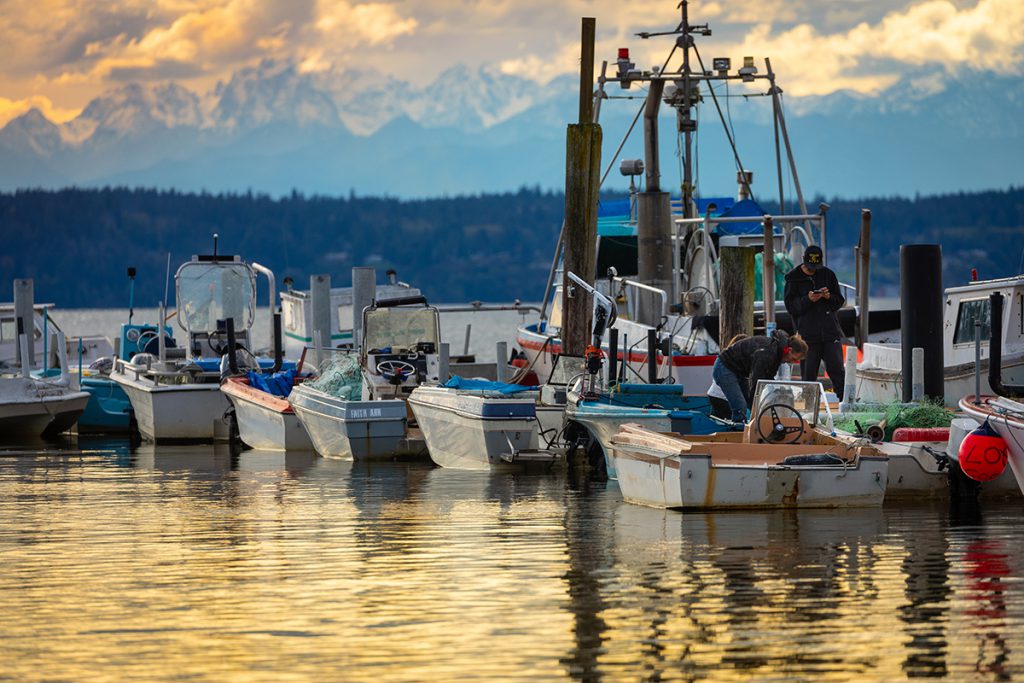What are the challenges to progress?
The Puget Sound Partnership Leadership Council presents these challenges to progress.
Funding does not meet the need
Priority Puget Sound recovery capital programs are consistently underfunded
During each state budget round, the Partnership provides the Governor’s Office with its ranked list of the highest priority funding requests needed to advance Puget Sound recovery.
In the last ten years, six of the most consistently high-ranked capital funding programs have repeatedly received awards that fall well short of what was requested (Table 1). In the latest 2021-23 funding round, all six of these programs ranked among the top seven capital budget requests.
From the 2013-15 biennium to the 2021-23 biennium the Legislature has funded some of the highest ranked Puget Sound restoration and protection programs at an average of 53 percent of what was asked, a $763 million gap, leaving many high priority projects languishing unfunded (see table 1). These programs provide tangible results and are a good investment of state dollars.
For example, the Puget Sound Acquisition and Restoration program (PSAR) has implemented 620 projects, restoring 6,449 acres of shoreline and producing 3,413 jobs. PSAR projects and many others are making a difference for salmon and the health of the ecosystem and people, but more needs to be done to build on these successes. Over the last 10 years the legislature has only funded 55% of the PSAR request.
| Funding proposal request | Agency | Description | Difference between original statewide request and enacted amount ($ millions) | % of requested amount funded |
|---|---|---|---|---|
| Salmon Recovery Funding Board (SRFB) | RCO | Awards grants to protect and restore salmon habitat. | $198 | 35% |
| Brian Abbott Fish Passage Barrier Removal Board (FBRB) | WDFW/RCO | Identifies and removes impediments to salmon and steelhead migration. | $94 | 44% |
| Centennial Clean Water Fund (CCWF) | ECY | Provides grants for water quality infrastructure and nonpoint source pollution projects. | $145 | 55% |
| Puget Sound Acquisition and Restoration (PSAR) | PSP/RCO | Supports projects that protect and recover salmon and salmon habitat in Puget Sound. | $200 | 55% |
| Estuary and Salmon Restoration Program (ESRP) | WDFW/RCO | Provides grants and technical assistance for projects that restore and conserve nearshore areas in Puget Sound. | $38 | 57% |
| Floodplains by Design (FbD) | ECY | Grant program for large-scale multi-benefit floodplain restoration projects that improve habitat, prevent flood hazards, and protect farmland. | $88 | 71% |
| TOTAL | $763 | 53% |
Table 1: Highly ranked state agency capital program requests, with significant long-term funding shortfalls (2013-15 to 2021-23 biennia).
Public funding for Near Term Actions in both the 2016-2018 Action Agenda and 2018-2022 Action Agenda does not meet the needs
Since 2008, the Puget Sound Action Agenda has identified the priority projects – Near Term Actions – the region must implement to advance Puget Sound recovery goals. Despite many stories of success, a significant shortfall in funding for Near Term Actions has persisted and that trend continued with for 2016-2018 and 2018-2022 Action Agendas. Funding for Near Term Actions comes from a variety of sources – over 100 different sources for the 2018-2022 Action Agenda – with just under half coming from the state and the other half from local and federal sources in roughly equal shares.
Among the Near Term Actions in the 2016-2018 Action Agenda only 37 percent were fully funded, with 38 percent partially funded and 25 percent not reporting any funding received. The total cost of all 2016-2018 Action Agenda Near Term Actions was about $182.5 million, with a funding gap of 48 percent ($88 million shortfall; figure 12) as of fall 2020, leaving only 21 percent of Near Term Actions fully implemented as planned.


Our most current reporting tells us that of 631 Near Term Actions in the 2018-2022 Action Agenda most are still in the planning or design stage, with only 20 percent of actions underway and just three percent completed. Around 90 percent of Near Term Action owners reporting a barrier to implementing their action cited a lack of funding and resources. The total cost of all 2018-2022 Action Agenda Near Term Actions is about $1.4 billion, with a current funding gap of 76 percent (figure 13). See the Action Agenda Tracker for the latest Near Term Action information.
It is critical the funding needs across Puget Sound are met. Around half of the 631 Near Term Actions in the 2018-2022 Action Agenda are ecosystem protection and restoration projects, which are typically funded—at least in part—by state capital investment programs. The costs of protecting Puget Sound will become increasingly expensive over time. We need to accelerate funding for our large capital programs and fully fund the Action Agenda for Puget Sound if we are to recover Puget Sound.
Changing ocean and climate conditions already affect the ecosystem
Every day, changing ocean and climate conditions are significantly affecting the health of our ecosystems as well as the economy, health, and wellbeing of communities across the region.
Because climate change is impacting ecosystems, wildlife, and people across Puget Sound, it is one of the largest obstacles we face as we work to create a more resilient Puget Sound. In the coming decades, increasingly severe climate impacts to the region will become an even greater obstacle to achieving our statutorily mandated biophysical and sociological recovery goals. In fact, each of the Partnership’s six statutory recovery goals is threatened by climate change and almost 90 percent of Puget Sound Vital Signs are at moderate to high risk of being impacted by climate change by 2050. See the goal reports in the “How is Puget Sound doing?” chapter for more details on how climate change impacts the ecosystem.
Projected climate impacts are alarming
Climate research predicts that a suite of alarming climate effects will appear across the region in the coming decades.
- Air temperature has already warmed, and climate projections show that, as warming accelerates, air temperature could reach 4.7°C above historical levels by the end of the century.
- Summer rainfall could decrease by as much as 27 percent by the end of the century and heavy rain events will become more intense in the last half of the century, increasing the risk and severity of flooding, erosion, and landslides.
- Peak snowpack is projected to decrease by 42 percent to 55 percent or more by the end of the century.
- River and stream temperatures—affected by warming air temperature, changes in precipitation, and decreased snowpack—could exceed 4°C-4.5°C above historical levels by the end of the century.
- Projections show that streamflow will increase by 18 percent to 42 percent during periods of peak flow and decrease by 16 percent to 55 percent during periods of low flow as a consequence of warming air, melting snow, drier summers, and more intense heavy rain events.
- Sea level rise, ocean warming, and ocean acidification have already begun and will accelerate throughout the century, resulting in an ocean that is 1.6 feet to 2 feet higher, as much as 2.8°C warmer, and 38 percent to 109 percent more acidic than historical levels by the end of the century.
Consequences to our Puget Sound community
Climate change will continue to profoundly affect the physical, mental, spiritual, cultural, and economic wellbeing of Puget Sound communities. Our overburdened communities will be impacted first, most often, and to the greatest extent. As climate change becomes more severe, humans will be increasingly affected by:
- Heat-related illnesses and deaths;
- Contamination of food by environmental contaminants;
- Contaminated freshwater and marine waters;
- Flooding and damage to low-lying infrastructure, homes, and businesses;
- Severe and frequent wildfires;
- Limited access to recreation and traditional cultural activities;
- Limited availability of traditional medicines; and
- Decreasing availability of local food.
These many climate impacts will continue to have profound and, in some cases, devastating consequences to the overall health and vitality of Puget Sound ecosystems and people. Predicted climate impacts can devastate communities across the region, particularly tribes, people of color, and other communities with the increased risks of flooding, property damage, health hazards, and pollution. Unabated climate impacts could quickly strip the region of its iconic natural resources, including salmon and orca, as well as the region’s many iconic landscapes and ecosystems as habitat is reduced and degraded. Local and customary foods may become scarce or too toxic to consume.
Puget Sound recovery work inherently increases climate resilience
 Projects that restore floodplains and riparian areas can increase climate resilience by decreasing flood risk during extreme rain events and providing shade to offset warming streams. Many Puget Sound recovery projects, like those that establish soft shorelines and restore estuaries, can decrease the magnitude of climate change by sequestering carbon and offsetting emissions, as well as increasing climate resilience. Maintaining natural pathways can increase resilience to climate impacts: rewetting wetlands reduces risk of fires; macroalgae conservation decreases shore erosion and beach loss; and restoring natural river flows can reduce flooding events.
Projects that restore floodplains and riparian areas can increase climate resilience by decreasing flood risk during extreme rain events and providing shade to offset warming streams. Many Puget Sound recovery projects, like those that establish soft shorelines and restore estuaries, can decrease the magnitude of climate change by sequestering carbon and offsetting emissions, as well as increasing climate resilience. Maintaining natural pathways can increase resilience to climate impacts: rewetting wetlands reduces risk of fires; macroalgae conservation decreases shore erosion and beach loss; and restoring natural river flows can reduce flooding events.
Along with strong action at the international and national level, locally we need to accelerate efforts to update policies, plans, practices, and procedures to account for climate impacts and increase climate preparedness. If provided with the necessary planning, funding, and political will:
urban areas can better plan for increased storm events, soaring temperatures, drought, and increased fire and smoke, as well as accelerate development of emergency response to failing infrastructure; agricultural areas can understand how flooding, heatwaves, and drought may impact crop production; and scientists and natural resource managers across the region can collaborate to better understand what ecosystems in the region can efficiently decrease the magnitude of climate change by sequestering and storing carbon in soils and vegetation.
2021 Northwest record-setting heatwave
The record-setting temperatures the Northwest experienced in the summer of 2021 would not have been possible in the absence of human-caused climate change. This extreme weather event shows some of the devastating effects climate change is already having on the people, wildlife, and environment across Puget Sound.
Although the many impacts of the heat wave—including the number of human lives lost—is not yet fully known, we know that the combination of extreme heat and low tides produced lethal conditions for local shellfish and aquatic wildlife.
In addition, urban heat islands common in the most urbanized areas in King County created inequitable health risks to local communities. High temperatures in the Northwest also caused extreme mountain snowmelt that washed out a bridge and inhibited recreation.
Developmental pressure is driving the conversion of ecologically important lands
The Puget Sound region has experienced extraordinary growth over the last decade. This growth has serious impacts on Puget Sound’s ecosystem and resources.
Puget Sound is developing faster than we can restore it
Recent data indicates that some of the benefits produced from restoring or protecting lands significant to water flow, habitat quality, or biodiversity in Puget Sound are already being offset by the continued degradation of habitat due to development. And between now and 2050, the population of the Puget Sound region is expected to increase by another 1.8 million people.
Population growth will increase development pressure
With population growth comes the increased demand for added infrastructure and maintenance, urban expansion and paved surfaces, shoreline development and armoring, and increased land use and transportation. Nearly 1.1 million acres, or 13 percent of the entire Puget Sound land area, are identified as both ecologically important and under high pressure for conversion to development. Due to land conversion from development pressures associated with population growth, many Puget Sound habitats have been reduced in size, diminished in quality, or have been fragmented. Ecosystem processes, like water quality, quantity, and flow, that form and sustain these habitats have been degraded and disrupted. While much of the population growth within the last 10 years has remained within urban growth areas, an increasing amount has occurred outside of these areas, with growing pressure to develop within rural areas close to urban growth boundaries.
With an ever-growing human population, rethinking development choices can not only help maintain the health of Puget Sound watersheds, but also develop resiliency to climate change, strengthen the capacity of its natural defense systems to keep contaminants out of our lands and waterways, buffer against flooding risk, and protect and maintain water quality. We must redirect development pressure and reduce conversion of ecologically important lands, while supporting working lands and protecting and restoring natural and vegetated areas.
We haven’t heard all the voices
 Puget Sound is a culturally rich and diverse region spanning 13 counties and hundreds of miles. It’s home to over 4.5 million people. Connections with the sea and local natural resources are abundant, with many communities economically and culturally tied to natural resource systems such as fisheries, agriculture, and timber. Effective ecosystem recovery requires a diverse representation of viewpoints, perspectives, and values from all affected communities and sectors, as well as scientific evidence to ensure an informed, sustainable, and supported effort.
Puget Sound is a culturally rich and diverse region spanning 13 counties and hundreds of miles. It’s home to over 4.5 million people. Connections with the sea and local natural resources are abundant, with many communities economically and culturally tied to natural resource systems such as fisheries, agriculture, and timber. Effective ecosystem recovery requires a diverse representation of viewpoints, perspectives, and values from all affected communities and sectors, as well as scientific evidence to ensure an informed, sustainable, and supported effort.
Together, we will generate the political will and momentum necessary to achieve a healthy and resilient Puget Sound
We need to engage farmers, timber workers, fishermen, business owners, and especially communities whose viewpoints have been historically left out of the ecosystem recovery effort. We need to seek out and listen to different concerns, engage with each other honestly, and work together to preserve the rich abundance of this place that we love. We’re facing big challenges that will require collective action from all of us.
We’re working to include the perspectives and values of the overburdened communities in the Puget Sound recovery effort. We see human wellbeing, environmental justice, and diversity, equity, and inclusion work as key to ecosystem recovery. Human health and quality of life are dependent on a healthy Puget Sound. As a recovery community, we must acknowledge and actively address inequities and injustices that exist within our recovery system.
To address systemic inequities, remove barriers to inclusive representation, and incorporate multiple forms of knowledge for environmental decision-making, the Puget Sound recovery community must: remove barriers and address disparities within decision-making processes; build trust and relationships with new partners and help amplify their voices within the recovery community; develop recovery strategies and commitments that address and integrate environmental justice; ensure that decision-making bodies within the recovery system represent a broad range of voices that guide our collective effort.

